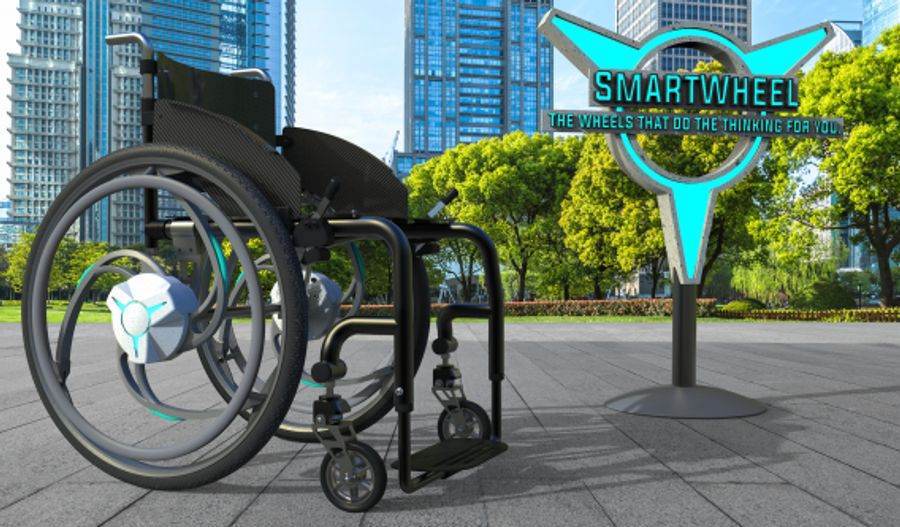Smart wheelchair wheel that helps with uneven terrain wins design competition

An innovative wheelchair wheel design that helps individuals with spinal cord injury has won Bolt Burdon Kemp’s Design the Change Competition.
In its second year, the competition is intended to raise awareness of the day-to-day challenges facing people with spinal cord injuries and how innovative designs can make a difference.
The competition invites UK-based university students to design a product aimed at improving the lives of people with a spinal cord injury. Law firm Bolt Burdon Kemp, which supports people with spinal cord injuries, was looking for a design which was both unique and practical.
Winner Thomas Salkeld, 23, a third-year Product Design BSc student from Cardiff Metropolitan University, designed the ‘Smart Wheel’. It is a motorised wheel that can be added to most wheelchairs and provides users with assistance on uneven ground, elevation and on long journeys. The wheel can be controlled from the user’s phone.
Thomas wins £3,000, with an additional £2,000 being awarded to Cardiff Metropolitan University.
Design the Change is supported by Bolt Burdon Kemp’s charity partner Cerebra, which works to improve the lives of children with neurological conditions. Part of the charity’s work is to design bespoke equipment to meet families’ needs at their innovation centre and, as part of his prize, Thomas will have a week’s placement at the centre in Wales next year.
Thomas really impressed the judges by researching his design thoroughly and taking into account the challenges facing those with a spinal cord injury who use a wheelchair. He bought a wheelchair himself and found travelling in it exhausting, especially uphill. He spoke to several people who had sustained a spinal cord injury and who were also wheelchairs users and ran his prototypes by them for feedback.
On winning the Design the Change competition, Thomas said: “I am ecstatic about winning the competition as designing to help people is my passion and what I wish to pursue in the future. The aim of my design was to really take into consideration what the users want and the problems they face every day in regards to their mobility in a wheelchair, then applying my engineering, design, prototyping and technology skills that were necessary.
“The aesthetics were designed to be functional but also pleasing to the eye, allowing the users to be proud of the product on their wheelchairs. I want to say a huge thank you to a number of people but first to Bolt Burdon Kemp and the judges for giving me the opportunity to participate in such an interesting brief and subject.
“I would like to thank James Dwyer, Louise Evans and Darren Povey for giving me feedback and a glimpse into some of the struggles they have in wheelchairs which really drove my project forward. Lastly I would like to thank my tutors Joe Venables and Clara Watkins for supporting me throughout the project.”
Highly commended in the competition and also offered a week’s placement at Cerebra is Anna Lis, 21, a third-year Product Design student at the University for the Creative Arts. Anna’s Superhuman Shoe and Ankle Foot Orthosis design provides support for people with drop foot, a common side-effect of a spinal cord injury. The judging panel were impressed with Anna’s detailed research and the fact her shoe celebrates the support it offers, rather than disguising its specialist features.
Victoria Oliver, the head of the spinal injury team at Bolt Burdon Kemp, said: “We were blown away by the quality of the entries this year and it’s fantastic to see how much research went into everyone’s designs.
“A spinal cord injury is a life changing event that makes even the most mundane of tasks time-consuming, and innovative designs and products can really help make the world more accessible to the 50,000 people living with a spinal cord injury in the UK.
“Thomas’ design showed real awareness of the challenges facing those with a spinal cord injury who use a wheelchair and he went to great lengths to make sure his Smart Wheel design was practical, comfortable, and aesthetically pleasing.”
Thomas’s design was judged by a panel of experts including Christa Dyson, Trustee for the Spinal Injuries Association; Dr Ross Head, Product Design Manager for the Cerebra Innovation Centre; Ian Hoskings, Club Chairman, Vice Coach and Player for Stoke Mandeville Wheelchair Rugby Club; Lady-Marie Dawson-Malcolm, Support Network Officer for the Spinal Injuries Association; and Doug Nevill, Head of Mechanical Design at Williams F1.

